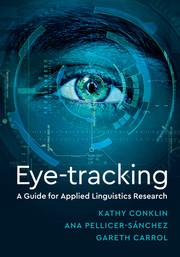Book contents
- Frontmatter
- Contents
- Figures
- Tables
- Preface
- Chapter 1 Introduction to Eye-Tracking
- Chapter 2 Choosing the Equipment
- Chapter 3 Practicalities of Eye-Tracking
- Chapter 4 Researching Reading
- Chapter 5 Researching Listening and Multimodal Input
- Chapter 6 Using Eye-Tracking in Other Contexts
- Chapter 7 Working with the Data
- Chapter 8 Conclusions
- References
- Index
2 - Choosing the Equipment
Published online by Cambridge University Press: 14 September 2019
- Frontmatter
- Contents
- Figures
- Tables
- Preface
- Chapter 1 Introduction to Eye-Tracking
- Chapter 2 Choosing the Equipment
- Chapter 3 Practicalities of Eye-Tracking
- Chapter 4 Researching Reading
- Chapter 5 Researching Listening and Multimodal Input
- Chapter 6 Using Eye-Tracking in Other Contexts
- Chapter 7 Working with the Data
- Chapter 8 Conclusions
- References
- Index
Summary
Introduction
A number of different eye-tracking systems are currently available to researchers. Despite the apparent similarity of the physical components of some of the current systems, important differences in their technical specifications mean that some systems are more suited to certain types of research questions than others. Some eye-tracking systems are presented as easy and effortless to use, and do indeed allow users to run an experiment with almost no knowledge of the system and limited understanding of experimental design. However, eye-trackers make advanced physiological measurements, and therefore knowing a system, its technical aspects and their impact on the quality of the data collected is crucial for determining whether a study will be feasible with a particular system (Holmqvist et al., 2011). Thus, choosing the right equipment and understanding its features and capabilities are of paramount importance for conducting high-quality eye-tracking research. The aim of this chapter is to provide an overview of the different types of eye-tracking systems available and of the main technical specifications that need to be considered when planning eye-tracking research. For practical reasons, it is not possible to review all eye-tracking systems currently available, so we will review the features of some of the most commonly used ones: EyeLink II, 1000/1000 Plus, Portable Duo (SR Research, www.sr-research.com); Tobii T/X series, Tobii Pro TX300 (Tobii, www.tobii.com); and iView X RED, RED and X Hi-Speed series (SensoMotoric Instruments (SMI), www.smivision.com).
Types of Eye-Trackers
Performing an eye-tracking experiment involves acquiring a continuous record of the eye's position relative to a visual stimulus, such that the recorded eye gaze is matched with the time course of the stimulus (Sedivy, 2010). For example, if we present participants with two images – x and y – we may want to know at specific time points where a participant was looking: at image x, image y or somewhere else. Most of the commercially available eye-trackers currently on the market are video-based systems, with eye-movements monitored by an infra-red camera directed at a participant's eyes. Recordings of the locations of the eyes are based on pupil-only detection or pupil and corneal reflection detections, with the latter being the predominant method. Pupil with corneal reflection tracking has the advantage of compensating for small head movements, which has made it the dominant tracking method (Holmqvist et al., 2011).
- Type
- Chapter
- Information
- Eye-TrackingA Guide for Applied Linguistics Research, pp. 14 - 32Publisher: Cambridge University PressPrint publication year: 2018



